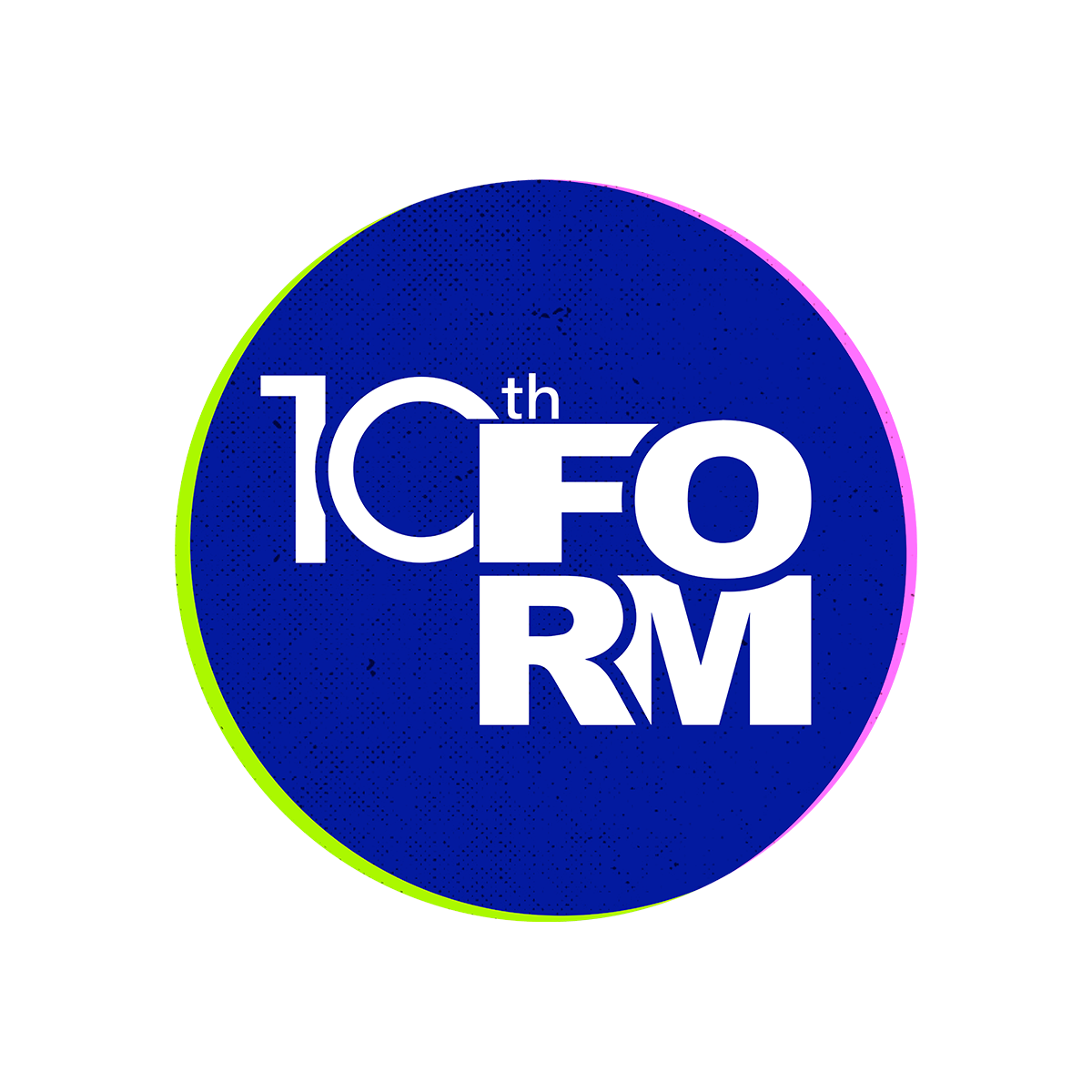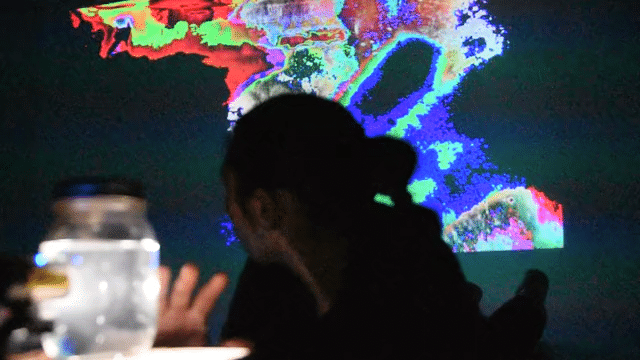Themes of technology and interaction have been woven throughout our programming since F-O-R-M’s inception. From interactive installations to multimedia dance works, to explorations of—and in—virtual spaces, we see a natural relationship between the body in motion and this branch of creation that takes movement-on-screen beyond filmmaking.
This year, we are piloting a new approach to this program. Now spanning two years, we aim to support artists over a longer period of time, allowing more depth and breadth to learn new skills and integrate new technologies into their projects and practices.
Year 1 - Research and Development
Year 2 - Research into the realization of the project with a presentation at our 2023 festival
This year, we’ve been hosting our first artist in residence, Jasmine Liaw, and her work in development SONIC COLOUR.
To highlight the research and development phase of the program, Sophia interviewed Jasmine amidst this research. A sneak peek at the work she’s been up to over the past several months!
Biography
Laura Zeke Photography
Jasmine Liaw is a queer emerging Chinese-Canadian interdisciplinary artist. Bicoastal, she lives and works in so-called Toronto and Vancouver. Her connective practice focuses on conceptual realms of dance and digital/new media landscapes. As an emerging artist, Jasmine is compelled to explore her contemporary views of identity and the agency of climate anxiety. She is a member of two Canadian art collectives, Chimerik 似不像 Collective, working in interdisciplinary research and creation, and Shoes Off Collective, an emerging artist community centred within the Asian Diaspora. In 2020, she graduated with Distinction at the Conteur Academy in Toronto, under the artistic direction of Eryn Waltman. Her work has been presented and commissioned internationally, and includes her original choreography, performance, film direction, projection design, editing, installation design, multi-media printmaking, and poetry. This year, she is a 2022 Artworkx Toronto Spotlight Artist. She is excited to be working in residency with F-O-R-M Recorded Movement Society in their Technology and Interaction Program. She is also currently working on her latest short film commission with RT Collective in partnership with Toronto Dance Theatre, in conjunction with Chimerik's project "Ritual Spective."
Interview
S: Jasmine, we’re so excited to have you be a part of our 2022 festival in residence as our Technology and Interaction artist. Since your film depen|dance was a part of our 2020 festival, we’ve been following your work and watching your practice develop beyond the screen and into other areas of technology. I’m curious to know more about your artistic practice, and how it’s evolved since 2020.
J: Thank you for this opportunity Sophia! My practice has expanded since 2020, and I am so grateful it started with F-O-R-M. In 2020, I graduated from the Conteur Academy in Toronto under the direction of Eryn Waltman. My film, depen|dance (also my first film ever!) was a collaboration within a practicum with Larchaud Dance Projects. I always had an interest in the documentation process of movement. Even in the creation process of that film, I offered many direction suggestions and asked many many questions to our DOP, Jono Lawley, as Jennifer Robichaud, the lead collaborator and choreographer, can attest to. Alike to choreographic processes, experimenting with the human body as a vessel for versatile art forms has allowed a generous range of possibilities that have evolved how I want to tell and even feel stories. I’m curious about the way technology has the capacity to express and magnify details of phenomenological consciousness. My work has evolved into an interdisciplinary practice that centres contemporary dance, film and new media. Experimenting within these disciplinary relationships, I am able to illustrate feelings of multiplicative identity. Visualizing emotional energies through technological embodiments has supported my approaches in creating unexpected or controlled perspectives and imaginative states of consciouness and unconsciousness. As I continue to explore my work, I’m excited to use this connective art practice as a voice for experiential relations.
S: I love all the ways in which your experience in dance and movement has influenced your relationship with film and media. This possibility in film and technology which allows us to feel our stories energetically as much as they are spaces to tell our stories is fascinating to me. As a dancer myself, the kinesthetic and embodied responses of how we witness films is also how I’ve always experienced these mediums. It’s exciting to see these influences blending together for you in this project.
S: How did you idea for SONIC COLOUR first develop and what was it inspired by?
J: In September 2021, I started working with Max MSP software. Studying audiovisual projection design, I was so intrigued by this idea of distorting digital imagery with the moving body.
Later in a Physical Computing: Interfaces class at OCAD University, I started exploring the paralinguistic response, the immersion of water, and how it triggers audio responses with a waterproof JSN-SR04T ultrasonic distance sensor with Arduino. Essentially, I was interested in developing an immersive communication system with natural and transparent elements.
In today’s climate, it’s quite frightening to think about the future. I can understand how anxiety inducing it can feel to think about the planet’s future. So many ecosystems are failing today and it all starts with water and the health of our oceans. I often create pieces that reflect on identity, but I feel as though it’s so unbelievably timely to be creating work that discusses these matters. Personally, I believe the way technology and movement connects to imagery and moving-imagery is deeply powerful and it matters to me that more interdisciplinary art responds as an advocate.
S: Absolutely timely. I am excited to see the integration of the element of water being a large part of this project. A tangible, felt and sensory material that can be present for audience members to reflect on and respond to physically is an exciting way to engage us in these themes. I imagine that the duet with audience and water being both unpredictable elements in this piece can be exciting, and perhaps sometimes difficult to work with and program?
J: For sure! It’s definitely exciting to be working with water and how sensorial it is, but water and technology don’t always mix. I’ve been experimenting with antidotes for this with the webcam and livestream equipment positioned outside of the tank, and also ideas of including movement with the webcam or a GoPro within the water. This phase of development has been very different from the first development and it’s thrilling to be navigating new territories of technological and interactive capacity.
S: What are some of the key mechanics you are using within the first development?
J: The first development of SONIC COLOUR embodied an installation where participants/viewers may interact with a tank of water. With an animated floor projection, the immersive cybernetic space explores the phenomenological consciousness of being present and giving into a sense of wonder.
The use of transparent materials represents nature’s vulnerabilities to economic/industrial decisions by humanity. The piece emulates a portal as if the participant emerges into an urgent calling state with the natural world. Its vibrant colours represent the overwhelmingness and blinding intensity of the space that mirrors climate anxiety. When the sensor is triggered due to the close proximity of the participant’s hand, a Cytron mp3 player shield plays the sound of a voicemail filtered glacier crashing into the ocean. The break of the ice, with the sensorial touch of the water, depicts human communication with the water and addresses the environmental stress and deterioration humanity has created on Earth.
S: Sounds like a true duet and negotiation between body and technology. Many possibilities and outcomes that can come from this meeting of body(ies), sounds and textures which influence one another. I can imagine feeling this overwhelm you speak about but also this sense of wonder and reflection which are manifested inside of the visualization of the projections.
S: How do you see the next phase of this installation evolving and embodying into?
J: I’m so grateful to have had this time in residence with F-O-R-M to further develop this installation. In this next phase, I’m critically interested in the nuance of surveillance. Looking at the glass tank as panels of an extended triptych, I want to integrate a projected live feed of the water interaction into the space of the installation. This will become a 4D multisensory presentation system combining real-time interaction with audio-visual sensitivity. I’m curious about the immersion of the water body and human body and how the action of projected surveillance opens up the conversation for widespread exposure in an installation space. Through experimentation in creative coding, I hope to create an immersive site in this phase of this installation, where the space is responsive within a 3 channel projection experience.
Currently, I’m investigating live-streaming water, as I pipeline it through Max MSP. Within this programming, I’m interested in replicating geographical illustrations through water interaction.
S: What kind of an experience do you hope audiences will have while immersed in this work?
J: I hope audiences can experience an intimate atmosphere within this work. As an immersive and interactive work, I hope to activate an empathetic relationship between humankind and the collapse of our ecosystem. For me personally, my work is a space responding to the balance and navigation of “self” and “site.
Informed by the intimacy of tactile forms, my work often integrates transparent inanimate matter and explores how these materialialities can relate to intimacy, vulnerability and empathy. Experimenting with materials such as glass, water, cellophane, plastic and integrating them with body movement allows an empathic space for both including restrictive and vulnerable feelings to be expressed and researched.
S: How has community been involved in this development of this work?
J: It matters to me that I represent my community views on climate change within the cultural constructs of my identity. Personally digesting the impacts on queer Chinese-Canadian art communities and young Asian diasporic artists during COVID-19, this is the most important time to be sharing personal and diasporic cultural art. This project is timely to explore compassion and understanding for our ecosystem and the pop cultural links that bridge and support our climate. To quote curator Henry Heng Lu, I hope that the sharing of art media will continue to be “a place where humans can be free of the fears of each other and ‘the other,’” holding space for healing.
Discovering various digital worlds through the energy of sound atmospheres and reactive landscapes, it’s exciting to share this information and further explore collaborative opportunities within the community.






